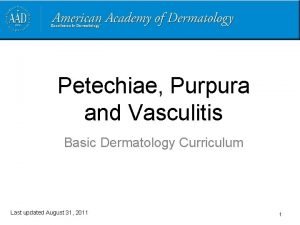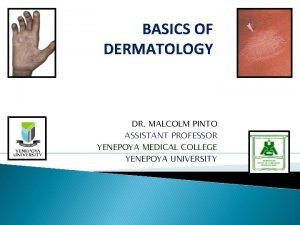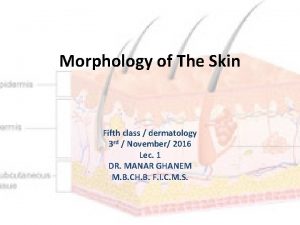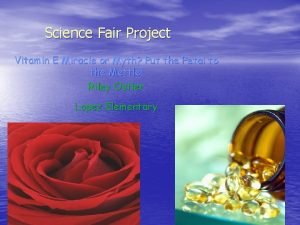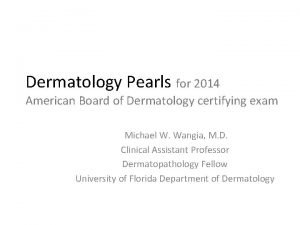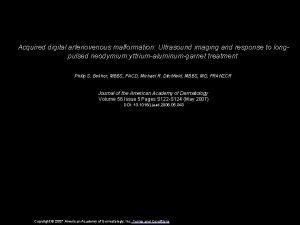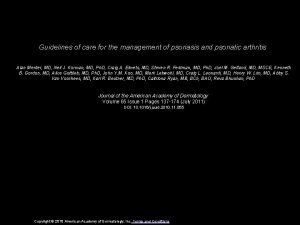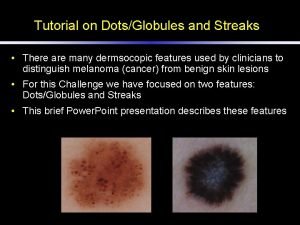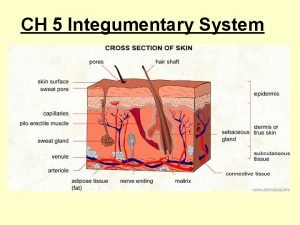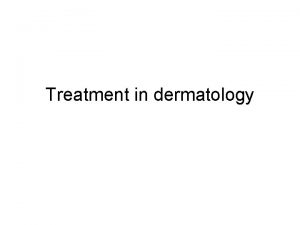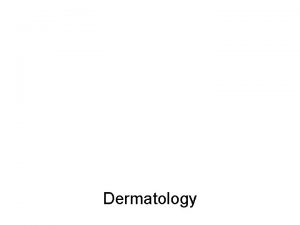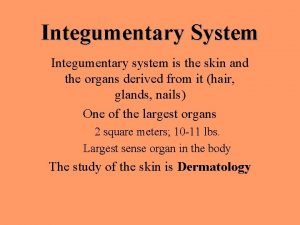Dermatology The Integumentary System Chapter 7 Integumentary System




































- Slides: 36

Dermatology The Integumentary System Chapter 7

Integumentary System • Large, flat, flexible body system that covers the entire surface of the body • Includes: skin (epidermis and dermis), sebaceous glands, sweat glands, hair and nails • Purpose: protect the body; first line of defense • Also includes sense of touch

Anatomy & Physiology: Skin • 2 layers • Epidermis: thin, outermost layer of the skin • Most superficial part contains cells filled with keratin (hard, fibrous protein that fills epidermal cells) • Form a protective layer • Dead cells are present and are constantly being shed or sloughed off (exfoliation) • Deepest part is the basal layer • Does not contain blood vessels • Contains melanocytes: pigment cells that produce melanin, a dark brown or black pigment.

Anatomy & Physiology: Skin • Dermis: thicker layer beneath the epidermis • Described as firm and elastic as it contains collagen and elastin • Includes arteries, veins, neurons, hair follicles, sebaceous glands and sweat glands • Dermatome: specific area on the skin that sends sensory information to the spinal cord.

Anatomy & Physiology • Sebaceous Glands (located in the dermis) • Exocrine Glands • a/k/a oil glands • Sweat Glands (located in the dermis) • • Exocrine Glands a/k/a sudoriferous glands Sweating regulates body temperature Perspiration: process of sweating; sweat itself • Hair • Covers most of the body; consistency and color vary • Hair is formed in the hair follicle in the dermis • Goosebump = piloerection (base of the hair follicle contracts and causes the hair to stand up)

Anatomy and Physiology • Nails • • Cover and protect the distal plate ends of the fingers and toes Outer layer is the nail plate Nail plate rests on the nail bed Cuticle is an edge of dead cells arising from the skin along the proximal end of the nail. • Subcutaneous Tissue • Loose, connective tissue • Not part of the integumentary system because it lies below the dermis • Composed of adipose tissue and lipocytes

Physiology of an Allergic Reaction • Allergy or Allergic Reaction: Hypersensitivity response to certain types of antigens known as allergens. • Allergens include cells from plant and animal sources (foods, pollens, molds, animal dander), as well as dust, chemicals and drugs. • Allergic reaction occurs when histamine is released from basophils in the blood and mast cells in the connective tissue. • Allergic reactions almost always involve the skin or mucous membranes

Allergic Reaction • 2 types of reactions • Local Reaction: • Occurs when an allergen touches the skin or mucous membranes of a hypersensitive individual. • Histamine is released in that area causes inflammation and redness (erythema), swelling (edema), irritation and itching (pruritus) • Systemic Reaction: • Occurs when allergens are inhaled by, ingested by, or injected into a hypersensitive person, causing symptoms in several body systems. • Histamine constricts bronchioles, dilates blood vessels throughout the body and causes hives on the skin (i. e. inhaled pollen, molds or dust trigger asthma attack) • Anaphylaxis: severe systemic allergic reaction that can be life threatening (a/k/a anaphylactic shock) • Symptoms include respiratory distress, hypotension and shock • Examples: eating peanuts, bee stings, medications

Exercises • Page 336 # 1 -37 • Page 363 • Matching • Circle • True/False

Diseases & Conditions: General • Dermatitis: any disease that includes inflammation or infection of the skin • Edema: Excessive amounts of fluid move from the blood into the dermis or subcutaneous tissue and cause swelling • Hemorrhage: trauma to the skin releases small or large amount of blood • Petechiae: pinpoint hemorrhages in the skin from ruptured capillaries • Contusion: any size of hemorrhage under the skin • Ecchymosis: hemorrhage under the skin that is 3 cm in diameter or larger (a/k/a bruise) • Hematoma: elevated, localized collection of blood under the skin

Diseases & Conditions: General • Lesion: any area of visible damage on the skin, whether from disease or injury • Neoplasm: a benign or malignant new growth that occurs on or in the skin. • Pruritis: itching • Rash: any type of skin lesion that is pink to red, flat or raised, pruritic or non-pruritic • Wound: any area of visible damage to the skin that is caused by a physical means (such as rubbing, trauma, etc) • Xeroderma: excessive dryness of the skin; can be caused by aging, cold weather with low humidity, vitamin A deficiency or dehydration (which can be assessed by testing skin turgor)

Diseases & Conditions: Changes in Skin Color • Albinism: a lack of pigment in the skin, hair, and iris of the eye; genetic; patient is said to be albino • Cyanosis: bluish-purple discoloration of the skin and nails due to decrease level of oxygen in the blood • Erythema: reddish discoloration of the skin; can be confined to one local area of infection or large areas of the skin (sunburn); area is said to be erythematous • Jaundice: yellowish discoloration of the skin, mucous membranes, and whites of the eyes; associated with liver disease • Necrosis: gray-to-black discoloration of the skin in areas where the tissue had died; necrotic tissue can occur in a burn, decubitus ulcer, wound or any tissue with poor blood supply. Necrosis with subsequent bacterial decay is called gangrene; area is said to be gangrenous.

Diseases & Conditions: Changes in Skin Color • Pallor: unnatural paleness due to lack of blood supply to the tissue; caused by blockage of an artery, hypotension or overexposure to cold • Vitiligo: autoimmune disease where melanocytes are slowly destroyed in irregular, ever-enlarging patterns; depigmentation

Diseases & Conditions: Skin Injuries • Abrasion: sliding injury that mechanically removes the epidermis; brush burn • Blister: repetitive rubbing injury that mechanically separates the epidermis from the dermis and releases tissue fluid • Burns: heat (fire, hot objects, steam, boiling water), electrical current (lightning, electrical outlets or cords), chemicals and radiation or x-rays (sunshine or prescribed radiation therapy) can cause a burn to the epidermis or dermis • First Degree • Second Degree • Third Degree

Diseases & Conditions: Burns • First Degree Burn: only the epidermis, causes erythema, pain and swelling but NO blisters • Second Degree Burn: involves the epidermis and the upper part of the dermis. Causes pain, erythema, swelling. Small blisters or larger bullae that form as the epidermis detaches from the dermis; a/k/a partial thickness burn • Third Degree Burn: involved the epidermis and entire dermis, and sometimes the subcutaneous tissue and muscle layer beneath may be involved; a/k/a full thickness burn. Eschar is a thick, crusty scar of necrotic tissue that forms on a third degree burn.

Diseases & Conditions: Skin Injuries • Callus: repetitive rubbing injury that causes the epidermis to gradually thicken into a wide, elevated pad. A corn is a callus with a hardened center and a pointed tip that causes pain and inflammation. • Cicatrix (a/k/a scar): fibrous tissue comprised of collagen that forms as an injury heals. A keloid is a very firm, abnormally large scar that is bigger than the original injury. • Decubitus Ulcer: constant pressure to a particular area of the skin restricts the blood flow to those tissues; a/k/a pressure sore or bed sore • Excoriation: superficial injury with a sharp object or fingernail or thorn that creates a linear scratch in the skin. • Laceration: deep, penetrating wound.

Diseases & Conditions: Skin Infections • Abscess: localized, pus-containing pocket caused by a bacterial infection. Furuncle is an elevated abscess around a hair follicle a/k/a boil; Carbuncle is comprised of large furnacles with connecting channels. • Cellulitis: spreading inflammation and infection of the connective tissues of the skin and muscle. • Herpes: skin infection caused by the herpes virus; clustered vesicles, erythema, edema and pain; vesicles rupture and release clear fluid that forms crusts. • Herpes Simplex Type 1 = cold sores • Herpes Simplex Type 2 = genital herpes • Herpes Whitlow = Simplex (1 or 2) infection at the base of the fingernail • Herpes Varicella-Zoster = chicken pox; shingles

Diseases & Conditions: Skin Infections • Tinea: fungal infection that feeds on the epidermal cells; originally thought to be a worm (a/k/a ringworm) • • Tinea Capitis: occurs on the scalp; hair loss Tinea Corporis: occurs on the trunk of the body Tinea Cruris: occurs in the groin and genital areas (jock itch) Tinea Pedis: occurs on the feet (athlete’s foot) • Verruca (wart): irregular, rough skin lesion caused by the human pappillomavirus. Usually o the hand, fingers or sole fo the foot.

Diseases & Conditions: Skin Infestations • Pediculosis: infestation of lice and their eggs (nits) in the scalp, hair, eyelashes or pubic hair • Scabies: infestation of parasitic mites that tunnel under the skin and produce vesicles that are itchy

Diseases & Conditions: Allergic Skin Conditions • Contact Dermatitis: local reaction to physical contact with a substance that is an allergen or irritant. • Urticaria: condition of raised areas of redness and swelling that appear quickly and disappear rapidly; a/k/a hives

Diseases & Conditions: Benign Skin Markings & Neoplasms • Actinic Keratoses: raised, irregular rough areas that are dry and feel like sandpaper. a/k/a solar keratoses • Freckles: benign, pigmented flat macule that develops after sun exposure • Hemangioma: congenital growth composed of a mass of superficial and dilated blood vessles. • Lipoma: benign growth of adipose tissue from the subcutaneous layer • Nevus: benign skin lesion that is present at birth and comes in a variety of colors and shapes; Port-wine stains are slightly elevated, red-to-purple vascular nevi that cover face and neck and are irregularly shaped; a/k/a birthmarks

Diseases & Conditions: Benign Skin Markings & Neoplasms • Papilloma: small, soft, fleshy growth of epidermis and dermis that protrudes outwardly; a/k/a skin tag • Premalignant Skin Lesions: abnormal skin lesions that are not yet cancerous; can become cancerous over time and with continued sun exposure or irritation • Senile Lentigo: light to dark brown macules with irregular edges; mostly on hands and face (areas chronically exposed to the sun) • Syndactyly: congenital abnormality in which the skin and soft tissues are joined between fingers and toes • Polydactyly: congenital abnormality in which there are extra fingers or toes. • Xanthoma: benign growth that is a yellow nodule orplaque on the hands, elbows, knees or feet; seen in patients with high levels of lipids in blood or have diabetes mellitus

Diseases & Conditions: Malignant Neoplasms • Malignancy: areas of the skin that are chronically exposed to ultraviolet light radiation from the sun • Basal Cell Carcinoma: skin cancer that begins in the basal layer of the epidermis; most common; slow growing and does not metastasize; raised pearly bumps • Malignant Melanoma: skin cancer that begins in the melanocytes in the epidermis; grows quickly and metastasizes to other parts of the body • A= asymmetry (one side of lesion has a different shape that the other) • B=Border (irregular or ragged) • C= Color (varies from black to brown or red in same lesion) • D= Diameter (greater than 6 mm)

Diseases & Conditions: Malignant Neoplasms • Squamous Cell Carcinoma: skin cancer that begins in the squamous superficial layer of the epidermis; begins as actinic keratosis; most common type of skin cancer; grows slowly • Kaposi’s Sarcoma: skin cancer that begins in the connective tissue or lymph nodes; commonly seen in AIDS patients; elevated tumors on the skin that are irregular and dark, reddish-blue.

Autoimmune Diseases with Skin Symptoms • Psoriasis: autoimmune disorder that produces excessive number of epidermal cells • Scleroderma: autoimmune disorder that causes the skin and internal organs to progressively harder due to deposits of collagen • Systemic Lupus Erythematosus (SLE): autoimmune disorder with deterioration of collagen in the skin and connective tissues; resulting joint pain, sensitivity to sunlight and fatigue

Diseases of the Sebaceous Glands • Acne Vulgaris: during puberty, the sebaceous glands produce large amounts of sebum, particularly on the forehead, nose, chin, shoulders and back. • Acne Rosacea: chronic skin condition in the face of middleaged patients; sebaceous glands secrete excessive amounts of sebum, blotchy erythema, superficial blood vessels, papules and edema • Seborrhea: overproduction of sebum, particularly on the face and scalp that occurs at a time other than puberty; In seborrheic dermatitis oily areas are interspersed with patches of dry, scaly skin and dandruff; a/k/a cradle cap in infants and eczema in children and adults

Diseases of the Sweat Glands • Anhidrosis: congenital absence of sweat glands and inability to tolerate heat. • Diaphoresis: profuse sweating; patient is said to be diaphoretic

Diseases of the Hair • Alopecia: acute or chronic loss of scalp hair • Folliculitis: inflammation or infection of the hair follicle (after shaving or plucking or removing hair with hot wax) • Hirsutism: presence of excessive, dark hair on the forearms and over the upper lip of a woman • Pilonidal Sinus: abnormal passageway that begins as a large, abnormal hair follicle that contains a hair that is never shed. • Schizotrichia: split ends

Diseases of the Nails • Clubbing: abnormally curved fingernails and stunted growth of the finger associated with chronic lack of oxygen with CF • Onychomycosis: fungal infection of the fingernails or toenails. • Paronychia: bacterial infection of the skin next to the cuticle

Lab and Diagnostic Procedures • Allergy Skin Testing: antigens in a liquid form are given by intradermal injections into the forearm. Scratch test is where the antigen is scratched into the skin • Culture and Sensitivity (C&S): specimen of the exudate from the ulcer, wound, burn or laceration or pus from an infection is cultured in a Petri dish • Skin Scraping: skin scraping is done with the edge of a scalpel to obtain cellular material from a skin lesion • Wood’s Lamp or Light: UV light used to highlight areas of skin abnormality; vitiligo appears bright white and ringworm appears blue-green because the fungus glows

Medical Procedures • Botox Injections: Botox is injected into the muscle to relax deep wrinkle lines on the face • Collagen Injections: procedure in which collagen is injected into wrinkles or acne scars • Cryosurgery: liquid nitrogen is used on a wart, mole or benign lesion; the nitrogen freezes and destroys the lesion. • Curettage: procedure that scrapes off a superficial skin lesion • Debridement: procedure in which a necrotic tissue is removed from a burn, wound or ulcer. • Electrosurgery: procedure that involves the use of electrical current to remove a nevus, wart, skin tag or small malignant lesion

Medical Procedures • Incision & Drainage: procedure to treat a cyst or abscess; scalpel is used to make an incision and the fluid is drained • Laser Surgery: procedure that uses pulses of a laser light to remove birthmarks, tattoos, enlarged superficial blood vessels (acne rosacea) or unwanted hair • Skin Examination: procedure to examine all of the patient’s skin or just one area of concern • Suturing: procedure that uses sutures to bring the edges of the skin together after a laceration or other injury.

Medical Procedures • Skin Resurfacing: removal of superficial and deep acne scars, fine or deep wrinkles or tattoos by means of chemicals, abrasion or laser treatments • Chemical Peel: skin resurfacing that uses chemicals to remove the epidermis • Dermabrasion: skin resurfacing that uses rapidly spinning wire brush or diamond surface to mechanically abrade the epidermis • Laser Skin Resurfacing: skin resurfacing that uses a computer controlled laser to vaporize the epidermis and some of the dermis • Microderm Abrasion: skin resurfacing that uses aluminum oxide crystals to abrade and remove the epidermis

Surgical Procedures • Biopsy: procedure to remove all or part of a skin lesion • Excisional: removal of an entire large lesion • Incisional: removal of part of a large lesion • Needle Aspiration: needle is used to aspirate fluid contents of a cyst • Punch Biopsy: circular metal cutter to remove a plug-shaped core that includes the epidermis, dermis and subcutaneous tissue • Shave Biopsy: a scalpel or razor blade is used to shave off a superficial lesion • Dermatoplasty: any type of plastic surgery • Liposuction: procedure used to remove excessive adipose tissue deposits from the breasts, abdomen, hips, legs or buttocks.

Surgical Procedures • Mohs’ Surgery: procedure to remove skin cancer, especially with irregular shapes and depths • Rhytidectomy: surgical procedure to remove wrinkles and tighten loose, aging skin on the face and neck; a/k/a facelift • Skin Grafting: procedure that uses human, animal or artificial skin to provide a temporary covering or permanent layer o skin over a burn or wound • Autograft: graft is taken from the patient’s own body • Allograft: graft is taken from a cadaver • Xenograft: skin graft of just the dermis is taken from an animal (pig); temporary • Synthetic Skin Graft: made from collagen fibers arranged in a lattice pattern; body does not reject and skin grows into graft

Exercises • Diseases and Conditions pg. 364 -365 • • Matching True/False Circle Matching
 Unit 3 integumentary system a&p chapter 5
Unit 3 integumentary system a&p chapter 5 Chapter 6 integumentary system
Chapter 6 integumentary system Hsp vs itp
Hsp vs itp Rajan dermatology
Rajan dermatology Malcom pinto
Malcom pinto Lida zheng
Lida zheng Emory dermatology clinic
Emory dermatology clinic Primary and secondary lesions of skin
Primary and secondary lesions of skin Dermatology science fair projects
Dermatology science fair projects Wpvr-230
Wpvr-230 Principles of topical therapy in dermatology
Principles of topical therapy in dermatology Etas dermatology
Etas dermatology Somc dermatologist
Somc dermatologist Dermatology
Dermatology Spaghetti technique
Spaghetti technique Dermatology
Dermatology Dermatology journal
Dermatology journal Dermatology journal
Dermatology journal Dermatology journal
Dermatology journal Valencia dermatology congress
Valencia dermatology congress Korzenko dermatology
Korzenko dermatology Mohs microsurgery
Mohs microsurgery Stallman
Stallman Dermatology billing performance
Dermatology billing performance Chapter 36 skeletal muscular and integumentary systems
Chapter 36 skeletal muscular and integumentary systems Glands in integumentary system
Glands in integumentary system Integumentary system vocabulary
Integumentary system vocabulary Fetal pig integumentary system
Fetal pig integumentary system Definisi sistem integumen
Definisi sistem integumen The integumentary system facts
The integumentary system facts The integumentary system exercise 7
The integumentary system exercise 7 Integumentary vocabulary
Integumentary vocabulary Integumentary system medical terminology
Integumentary system medical terminology Integumentary system
Integumentary system Integumentary system assessment
Integumentary system assessment Integumentary system analogy
Integumentary system analogy The integumentary system
The integumentary system


